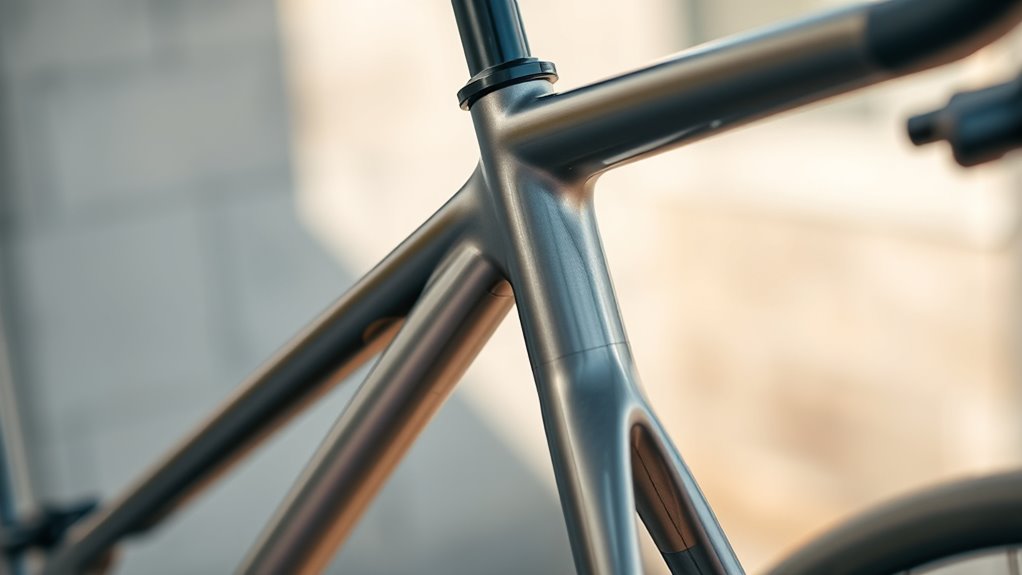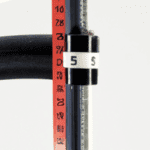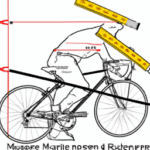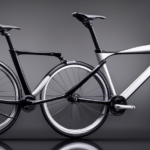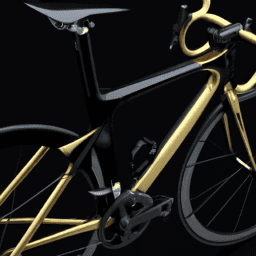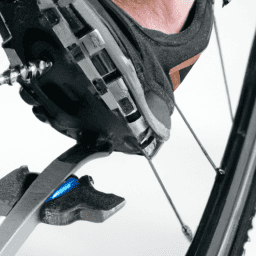Understanding bicycle frame geometry helps you optimize ride quality, handling, and comfort. Key measurements like top tube length, head tube angle, wheelbase, and chainstay length influence how stable, agile, and comfortable your bike feels. Different geometries suit various riding styles, from quick, responsive cornering to steady long-distance rides. Choosing the right geometry based on your body size and riding goals improves confidence and enjoyment. Explore more to see how specific features affect your ride experience.
Key Takeaways
- Frame geometry determines riding posture, handling, stability, and comfort by influencing angles, lengths, and proportions of key components.
- Reach, stack, and top tube length affect rider fit, control, and overall riding experience.
- Head tube angle and fork rake impact steering responsiveness and bike stability at various speeds.
- Wheelbase and chainstay length influence bike maneuverability, ride comfort, and cornering behavior.
- Modern geometry trends balance aerodynamics, wider tires, and rider ergonomics to optimize ride quality across terrains.
The Role of Frame Geometry in Bike Handling and Comfort
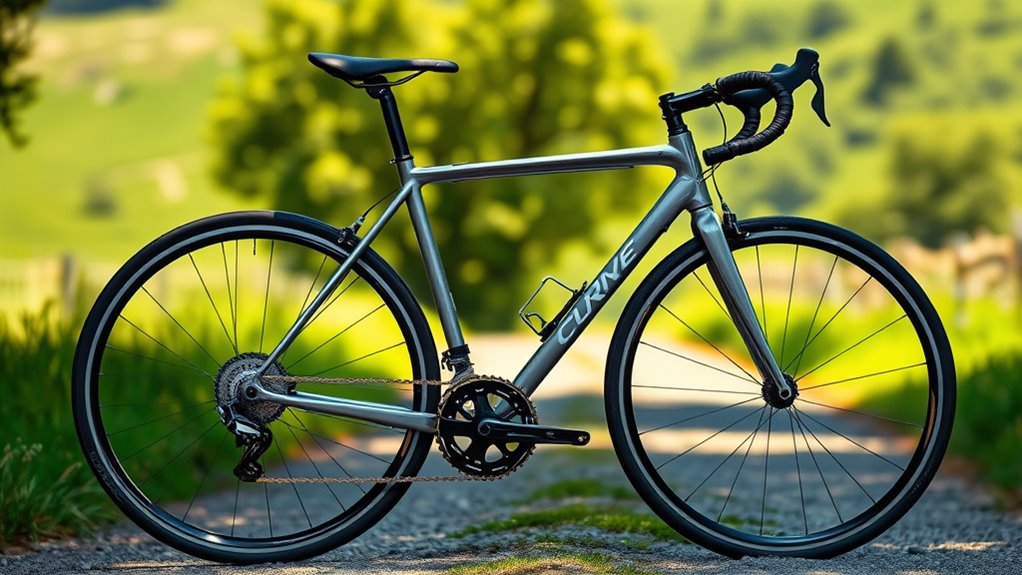
Frame geometry plays a crucial role in how your bike handles and how comfortable you feel during rides. The head tube angle influences responsiveness; a steeper angle offers quicker steering, while a slacker angle provides more stability at high speeds. Wheelbase affects handling and comfort—longer wheelbases improve stability and reduce twitchiness, making your ride smoother. Reach and top tube length determine your position, impacting control and comfort. Frame geometry also influences ride quality by balancing responsiveness with stability. Fork offset works with the head tube angle to fine-tune handling characteristics, ensuring precise steering. Proper frame fit is essential for optimizing handling and comfort, as it directly affects rider posture and control. Together, these factors shape your overall riding experience, affecting everything from quick turns to long-distance comfort, so understanding how they interact helps you choose a frame that matches your riding style. Additionally, frame geometry is essential for customizing a bike that fits your specific needs and riding preferences.
Key Measurements That Define Bike Geometry

Understanding the key measurements that define bike geometry helps you find a frame that fits your riding style and improves handling. The top tube length, especially the effective top tube, influences your reach and overall riding position. The head tube angle affects steering responsiveness; steeper angles offer quicker handling, while slacker angles provide stability. Wheelbase, determined by the front and rear hub distance, impacts stability and maneuverability—longer wheelbases deliver smoother rides. Chainstay length influences responsiveness and comfort; shorter stays make the bike more agile, while longer stays enhance stability. The seat tube angle affects your saddle position and power transfer. Additionally, head tube length, length of the seat tube, reach, and stack all contribute to fit and riding dynamics, ensuring the bike suits your needs. Incorporating bike geometry considerations into your choice can significantly improve your overall riding experience. Proper soil moisture monitoring and adjustment can also help optimize your bike’s performance in outdoor environments. Furthermore, understanding how vetted components and measurements impact riding can lead to more informed decisions when selecting bike parts or customizing your setup. A thorough knowledge of these measurement specifications allows riders to tailor their bikes precisely to their personal preferences and terrain requirements. Recognizing the odor associated with various bike materials, like certain plastics or rubbers, can also assist in maintenance and comfort.
How Different Geometries Suit Various Riding Styles
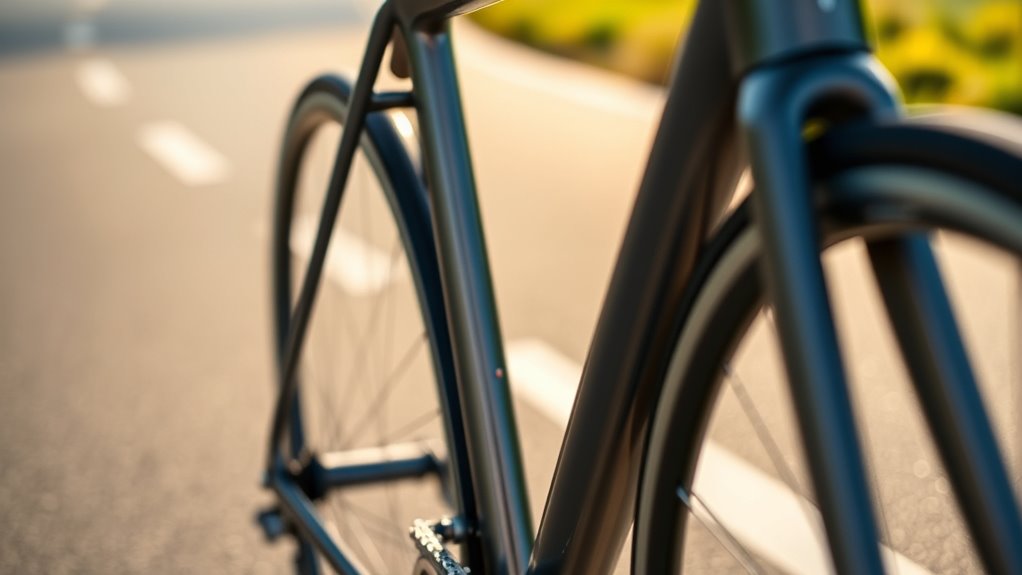
Your riding style greatly influences the bike geometry that’s best for you. Race bikes prioritize aerodynamics and responsiveness, while endurance bikes focus on comfort and stability over long distances. Understanding how handling, stability, and rider flexibility come into play helps you choose the right setup for your rides. Additionally, customization options allow for tuning your bike’s geometry to better suit specific riding conditions or personal preferences. Considering frame angles and how they affect riding position can further improve your comfort and performance. Moreover, being aware of material choices can influence ride quality, weight, and durability, helping you make a more informed decision tailored to your riding needs. Recognizing how self-watering plant pots work can serve as a helpful analogy for understanding how different frame geometries maintain balance and support optimal performance, especially when considering how storage conditions impact the longevity and safety of your bike components.
Race vs. Endurance Fit
The geometry of a bicycle frame directly influences how it performs and feels during rides, making it essential to choose the right fit for your riding style. Race bikes feature a steeper head tube angle (~73°), longer reach, and lower stack height, creating an aggressive riding position that enhances aerodynamics. Their frame geometry emphasizes a longer wheelbase and shorter chainstays, improving responsiveness and agility. In contrast, endurance bikes have a slacker head tube angle (~71°), shorter reach, and higher stack height, offering a more upright riding position for comfort and stability over long distances. The tube length, top tube, and seat tube angles all contribute to the overall riding position, with endurance frames prioritizing stability and comfort, while race frames focus on speed and responsiveness. Additionally, bike frame geometry plays a crucial role in determining the overall ride quality and suitability for different terrains and riding conditions, which is an important aspect of retirement planning to consider when ensuring long-term comfort and performance.
Handling and Stability Balance
Different frame geometries considerably influence how a bike handles and feels on the road or trail. A slacker head tube angle (around 70°) boosts stability and control at high speeds, ideal for downhill or gravel riding. Longer wheelbases (1050 mm) improve bike stability and ride quality over rough terrain, while shorter wheelbases enhance responsiveness and quick handling. Longer chainstay lengths (410 mm) add stability for touring or off-road use, whereas shorter stays increase agility. The table below illustrates how these factors affect bike balance and handling:
| Geometry Feature | Impact on Handling & Stability |
|---|---|
| Head tube angle | Slacker = more stability, steeper = more responsiveness |
| Wheelbase | Longer = stable, shorter = nimble |
| Chainstay length | Longer = smoother ride, shorter = agile cornering |
| Trail | More trail = stability, less trail = quick steering |
| Overall geometry | Balances stability vs. responsiveness for various styles |
Additionally, understanding bike fit is essential for optimizing handling and comfort according to individual riding preferences. Proper geometry selection can significantly influence rider confidence and control across different terrains. Recognizing how frame angles affect steering and stability helps riders choose the right setup for their specific riding style and terrain conditions. Moreover, considering rider position in relation to frame geometry can further enhance comfort and performance on long rides.
Rider Flexibility Considerations
Choosing a bike that matches your flexibility level is essential for comfort and performance. If you have limited flexibility, look for bikes with a taller head tube and more upright riding position, which reduce strain on your back and neck. A slack seat tube angle and shorter top tube length can promote stability and ease of reach. Adjustments like higher handlebar height, shorter stem length, and appropriate frame size help customize fit without changing the fundamental geometry. Reach and stack measurements are key to ensuring proper fit, especially if you prefer a more relaxed posture. Bikes designed with these considerations support comfort, especially for endurance or comfort-oriented riding. Understanding how frame geometry aligns with rider flexibility ensures you select a bike that’s both comfortable and suited to your riding style. Cookie management options can also help tailor your browsing experience when researching different bike geometries and fitting recommendations. Additionally, considering the aerodynamic qualities of various frame geometries can impact your efficiency and comfort during longer rides. Moreover, incorporating knowledge of AI in Education can assist in personalized fitting programs that adapt to rider needs over time.
Impact of Frame Size on Geometry and Performance
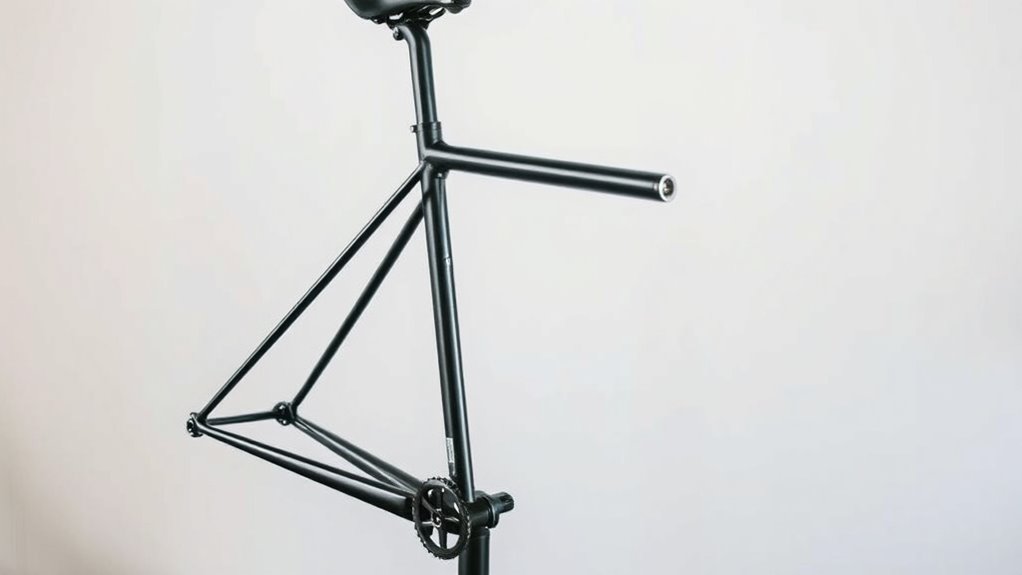
Choosing the right frame size directly affects how comfortable and well-fitting your ride feels. It also impacts how your bike handles, with smaller frames offering quick responsiveness and larger frames providing stability. Understanding these differences helps you select a bike that matches your riding style and enhances performance.
Fit and Comfort
Ever wondered how your bike’s frame size influences your comfort and performance? Your bike fit depends heavily on proper frame size, which affects geometry and rider position. A well-chosen frame ensures ideal saddle height, reach, and stack, promoting comfort and efficiency. An ill-fitting frame causes discomfort, pain, or injury by misaligning tube length and head tube angle. The table below highlights how different frame sizes impact your ride:
| Frame Size | Rider Position | Geometry Effect |
|---|---|---|
| Small | Aggressive, aerodynamic | Shorter tube length, lower stack |
| Medium | Balanced, comfortable | Moderate reach and stack |
| Large | Upright, relaxed | Longer tube length, higher stack |
Matching frame size to your body ensures better control, less fatigue, and a more enjoyable ride.
Handling and Responsiveness
Have you noticed how your bike responds differently when you ride a larger versus a smaller frame? Larger frames tend to have a longer wheelbase and a more relaxed head tube angle, providing greater stability and smoothness at high speeds. Smaller frames, with shorter chainstay lengths and a more aggressive head tube angle, offer sharper maneuverability and quicker steering. The frame size influences overall bike geometry, affecting steering precision and agility. Handlebar width and stem length also play crucial roles—wider bars and longer stems can enhance control, especially in tight turns. Properly matched frame size ensures the right balance of responsiveness and stability, making your bike feel more agile or stable according to your riding style and terrain.
Modern Design Trends and Their Influence on Geometry
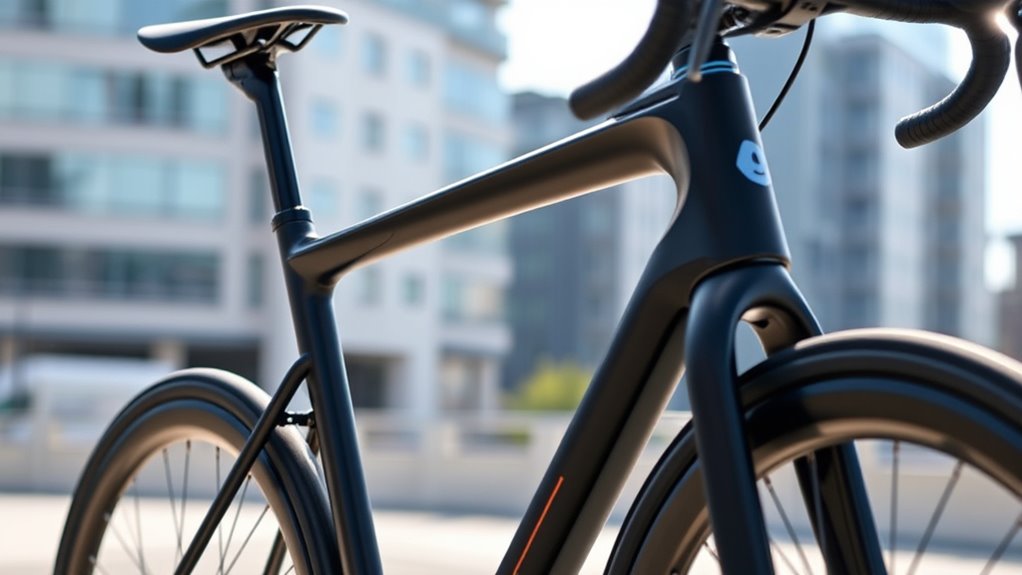
Modern bike design trends are markedly reshaping frame geometry to better meet rider needs and technological advancements. Modern geometry emphasizes larger tire clearance, supporting wider tires (28mm and above) for better grip and comfort. Frame design now prioritizes stack and reach for ideal fit, while slacker head angles and longer wheelbases enhance stability across varied terrains. Increased fork rake improves handling characteristics, especially with wider tires, without sacrificing responsiveness. These changes aim to balance aerodynamics and rider comfort, allowing for aggressive riding positions without compromising control. The focus on versatility means geometry adjustments accommodate both speed and stability, reflecting current trends in bicycle design. Overall, these innovations create a more adaptable, comfortable, and capable ride tailored to a wide range of cycling experiences.
The Interplay Between Geometry Elements and Ride Dynamics

The way different geometry elements interact directly shapes how your bike responds during rides. Your head tube angle, trail, and fork rake work together to influence steering responsiveness and stability. A longer wheelbase and chainstay length enhance ride comfort and control, while shorter stays make handling more agile. Changes in reach, stack, and handlebar position affect your riding posture and responsiveness, impacting how quickly you react to steering inputs. The bottom bracket height and trail shape your bike’s center of gravity and steering feel, affecting overall stability.
- A steeper head tube angle improves quickness but may reduce stability.
- Longer wheelbase and chainstay length boost comfort and control.
- Adjusting reach and handlebar position alters responsiveness.
- Trail and bottom bracket height influence steering precision and stability.
Choosing the Right Geometry for Your Riding Needs

Choosing the right bike geometry starts with understanding how your riding style and terrain influence your frame preferences. If you prefer aggressive riding, a steeper head tube angle and shorter chainstay length improve responsiveness. For stability on rough terrain, a slacker head tube angle and longer wheelbase are better. Consider your bike fit—reach and stack, top tube length, and frame size should match your body measurements. A relaxed riding style benefits from longer top tubes and handlebar positions, while a race-oriented rider prefers shorter, more aggressive geometries. Use this table to guide your choice:
| Factor | Effect on Ride |
|---|---|
| Head tube angle | Stability vs. agility |
| Wheelbase | Handling, comfort |
| Reach and stack | Fit, riding position |
| Chainstay length | Responsiveness, stability |
How to Read and Interpret Bike Geometry Charts
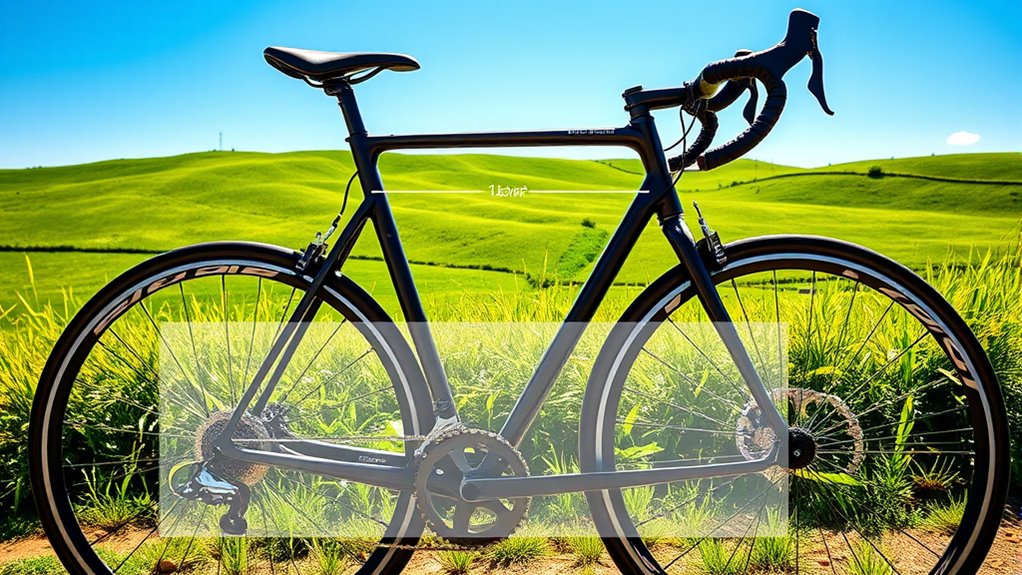
Understanding how to read and interpret bike geometry charts is essential for selecting a bike that matches your riding style and fit. These charts display key measurements like top tube length, head tube angle, wheelbase, reach, and stack, which influence ride handling and comfort. Effective measurements, such as effective top tube length, help you gauge your riding position more accurately. Interpreting the chart involves understanding how these measurements interact—longer reach with a slacker head tube angle creates a more aggressive ride. Keep in mind that different manufacturers may present measurements differently, so comparing charts requires understanding their specific definitions. Using the geometry chart alongside your riding needs ensures a bike fit that offers ideal handling, comfort, and performance.
- Understand how top tube length and reach affect your riding position
- Recognize how head tube angle influences handling and stability
- Compare effective measurements for accurate bike fit assessments
- Analyze wheelbase to determine ride responsiveness and comfort
Frequently Asked Questions
How Does Bike Geometry Affect the Ride?
Bike geometry affects your ride by influencing how responsive and stable your bike feels. A slacker head tube angle gives you calmer steering, great for rough terrain or high speeds. Longer wheelbases boost stability and comfort, while shorter ones make your bike more agile. Adjustments to top tube length, reach, and other angles change your riding position, control, and comfort—so you can tailor your bike to match your riding style and terrain.
How Much Does Bike Geometry Matter?
Bike geometry really matters because it directly influences how your bike handles, feels, and performs. The right geometry can make your ride more comfortable, efficient, and responsive, especially on different terrains. Even small changes in angles or measurements can notably impact stability and control. So, choosing a bike with geometry that matches your riding style ensures you enjoy smoother rides, less fatigue, and better overall performance.
How Can You Tell if a Bike Is Good Quality?
To tell if a bike is good quality, look at its craftsmanship—smooth welds and a flawless finish matter. Check if it uses high-grade materials like carbon fiber or aluminum for durability and weight. Examine the components—top brands like Shimano Ultegra or SRAM Force mean better performance. Also, confirm the frame geometry aligns with industry standards and the bike has proper certifications, ensuring reliability and safety for your ride.
What Is Aggressive Geometry on a Bike?
Aggressive geometry on a bike means it’s built for speed and sharp handling. You’ll notice a steeper head tube angle, longer top tube, and a shorter stem, which create a more stretched, aerodynamic riding position. The handlebars sit lower compared to the saddle, putting you in a forward-leaning stance. This setup makes the bike more responsive and suitable for racing or fast-paced riding, but it can sacrifice comfort over long distances.
Conclusion
Think of bike geometry like a recipe—you’ll want the right ingredients for your perfect ride. Once, I swapped my bike’s stem length, and suddenly, handling felt sharper, like turning a well-tuned dance partner. Understanding these measurements helps you craft a ride that fits your style, whether leisurely or competitive. When you choose wisely, your bike becomes an extension of yourself—smooth, responsive, and just right for every journey ahead.
